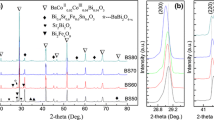Abstract
Microstructures have been examined for superhigh-resistivity thick films having typical resistivities of 108–1011 Ω/□ and based on Sn0.9Sb0.1O2-Sb2O4 and Pb2Ru2O6 powders, amorphous glass, and crystallizing glass. The temperature dependence of the resistance has been measured at 77–870 K. Films based on Sn0.9Sb0.1O2-Sb2O4 mixtures have a chain structure, which consists of a network of particles of the conducting phase and groups of them, which are arranged around the particles of glass. There is a random distribution of the Pb2Ru2O6 particles in the glass matrix, and mutual diffusion occurs between the phases. The temperature dependence of the resistance is of activation type, which is due to carrier transport through the thin glass layers.
Similar content being viewed by others
References
D. E. Dyshel’, B. M. Rud’, and A. I. Tereshin, “Pastes for superhigh-value resistors,” in: Communications Engineering, Series Production Technology and Equipment, No. 4, 52–56 (1990).
M. V. Vlasova, D. E. Dyshel’, and N. G. Kakazei, “Formation of finely divided particles in the heat treatment of tin and antimony hydroxide mixtures,” Izv. AN SSSR, Neorg. Mater.,26, No. 7, 1486–1490 (1990).
R. G. Ainshtein, L. A. Bespamyatnova, V. P. Komarova, et al., “A high-temperature glass as a matrix element in silver—palladium resistors,” Élektron. Prom., No. 2, 26–28 (1976).
V. Z. Petrova, A. V. Pislyakov, T. M. Morozova, et al., “A glass for resistors,” Inventor’s Cert. 1175898 USSR, Otkrytiya. Izobret., No. 32, 109 (1985).
D. E. Dyshel, B. M. Rud’, and M. D. Smolin, “Electrical conductivities of composite thick films based on powders of doped tin dioxide,” Poroshk. Metall., No. 12, 65–69 (1984).
R. Ya. Khodakovskaya, É. I. Abdrashimova, N. M. Pavlushkin, et al., “The behavior of small amounts of tin in the crystallization of glasses in the Li2O−Al2O3−SiO3−TiO3 system,” Fiz. Khim. Stekla,6, No. 1 60–67 (1980).
V. G. Grebenkina, D. E. Dyshel’, M. D. Smolin, and V. N. Fedorov, “Conduction mechanisms of resistive thick films based on lead and bismuth ruthenates,” in: Communications Engineering, Series Production Technology and Equipment, No. 2, 26–28 (1990).
G. E. Pike and C. H. Seager, “Electrical properties and conduction mechanisms of Ru-based thick-film (cermet) resistors,” J. Appl. Phys.,48, No. 12, 5151–5169 (1977).
D. E. Dyshel’, B. M. Rud’, and M. D. Smolin, “Origin of the activated conductivity in composite films based on powders of doped tin dioxide and glass,” Poroshk. Metall., No. 11, 63–67 (1987).
D. E. Dyshel’, “Frequency dependence of the resistive component of the impedance for thick-film resistors based on Sn0.9Sb0.1O2 powders,” ibid., No. 10, 42–47 (1992).
I. P. Zvyagin, Kinetic Phenomena in Disordered Semiconductors [in Russian], Izd. Mosk. Univ., Moscow (1984).
N. Mott and E. Davis, Electronic Processes in Noncrystalline Substances, in two volumes [Russian translation], Mir Moscow (1982).
R. C. Hughes, “Time-resolved hole transport in α-SiO2,” Phys. Rev. B,15, No. 4, 2012–2020 (1977).
A. Felz, Amorphous and Vitreous Inorganic Solids [Russian translation], Mir, Moscow (1986).
Additional information
Materials Science Institute, Ukrainian Academy of Sciences, Kiev. Translated from Poroshkovaya Metallurgiya, Nos. 11-12, pp. 88–93, November–December, 1997.
Rights and permissions
About this article
Cite this article
Dyshel’, D.E. Structure and temperature dependence of resistance in very high resistivity thick films. Powder Metall Met Ceram 36, 643–647 (1997). https://doi.org/10.1007/BF02676155
Received:
Issue Date:
DOI: https://doi.org/10.1007/BF02676155




